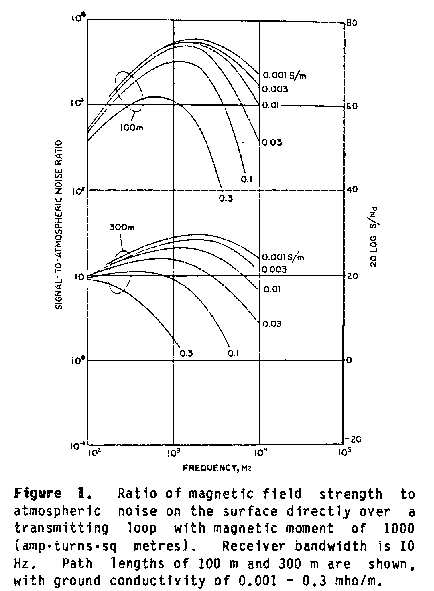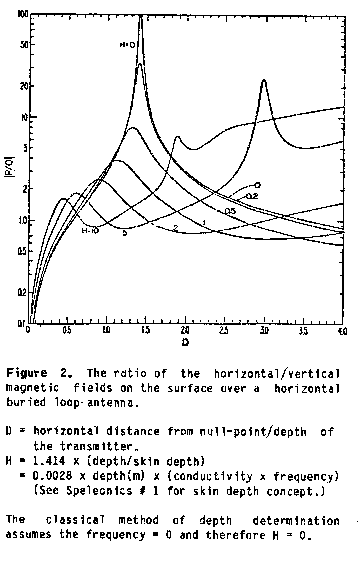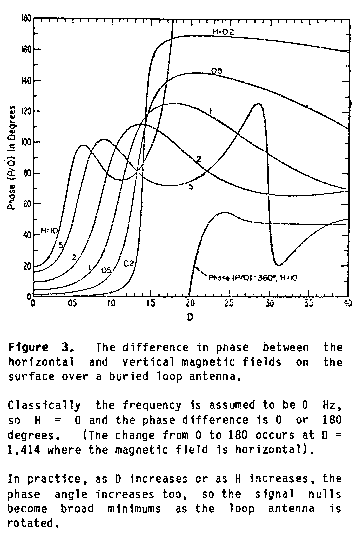MAGNETIC MOMENTS, Number 5
THE PHASE PROBLEM
(originally printed in Speleonics 7, Winter-Spring 1986-87)
By Ian Drummond
Many discussions of cave radio technology have centred on the problem of obtaining maximum range by choosing an "ideal frequency" of operation.
The earliest work recognized that the lower the frequency, the less the attenuation of the magnetic field by the conductive rock, but little recognition was given to the effect of atmospheric noise. In 1970 Nevin Davis published a quantitative model (1) which predicted among other things that frequencies as high as 1.8 MHz would be useful for voice communication. Davis actually made the pessimistic assumption that the magnetic field was subject to exponential attenuation by the earth. In fact the weakening of the signal is less severe, and consequently the higher frequencies will be even more useful than Davis predicted.
A very useful description of the work done by the US Bureau of Mines is reported by Linfield (2) and gives optimum frequency curves for CW (Morse) signals (Fig. 1). Similar curves could be developed for voice communication. Linfield reports the best frequency for voice communication, when limited by mine electrical noise, is 30-40 kHz at 100 m depth.

My conclusion from all this information is that practical communication systems can work at depths exceeding 100 m for a wide range of frequencies, from 3 kHz (CW) to over 100 kHz for voice.
There is, however, a further problem not considered in the above models, which may influence the choice of frequency for a cave radio system. I call it The Phase Problem, and it arises because of the way cavers use the geometry of the magnetic field to locate the position and depth of the transmitter. All the current methods (3,4) rely on rotation of a loop antenna until no signal is detected, at which time the plane of the loop is parallel to the oscillating magnetic field. Unfortunately the effect of the conductive ground is not just to weaken the intensity of the magnetic field, but also to induce a component which is out of phase. As a result the magnetic field on the surface above the cave is no longer plane-polarized, but rotating. Its directional characteristics are weakened and a broad signal minimum only can be detected. This effect is more marked with increasing depth of the transmitter and with increasing distance on the surface from the null-point above the transmitter. The effect can become so extreme that all directional sense in the signal is lost and a strong signal is received whichever way the antenna is rotated. The effect is much more noticeable when measuring depth than when locating the null-point with the antenna plane vertical.
Based on my own experience with the ASS cave radio operating at 115 kHz, I feel I can get reliable null locations to depths of 150-200 m, but depth determination is difficult  when the antenna is deeper than 100 m. Even when the antenna is shallower, there is difficulty getting directional signals at horizontal distances exceeding 2x the depth from the null-point (although voice communication is perfectly clear).
when the antenna is deeper than 100 m. Even when the antenna is shallower, there is difficulty getting directional signals at horizontal distances exceeding 2x the depth from the null-point (although voice communication is perfectly clear).
The subject has been treated theoretically by J.R. Wait(5). Two graphs from the paper are shown here (Figs 2 & 3). The conventional method of measuring depth assumes H = 0, and P/Q is measured directly as 1/Tangent(antenna angle at null). In the real world, as H increases (due to increasing depth of transmitter, or increasing conductivity of the ground) the null angle of the antenna is harder to detect as the phase angle of P/Q deviates from 00 or 1800 (Fig 3).  Moreover, the value of P/Q estimated from the angle of minimum signal gives increasing error in the depth estimate if it is used in the equations which assume H = 0. (Fig. 2)
Moreover, the value of P/Q estimated from the angle of minimum signal gives increasing error in the depth estimate if it is used in the equations which assume H = 0. (Fig. 2)
All these effects are minimized if the surface receiver is near the null-point on the surface (D = 0). Therefore if the operator of a cave radio does observe these problems, at present the best solution is to move closer to the null point. This may involve a box-search of an area if the signals have no directionality at all, as has happened to me on occasion.
Conclusion. As radios improve and their range extends, new considerations will determine the best operating frequency. For long range voice communication, frequencies above 30 kHz will probably prove best but position location work will be limited to depths less than 150-200 m. For location work at greater depths, lower frequencies will be needed. The common 3.5 kHz frequency will probably work to depths up to 500-600 m depending on the conductivity of the earth.
References
- Davis N., Optimum frequencies for underground radio communication. Nat. Speleo. Soc. Bulletin Vol 32, #1, 11-26 (1970)
- Linfield R.F., An Overview of Underground Communications. Westinghouse Georesearch Laboratory, Boulder, Colorado
- Mixon W., Blenz R., Locating an underground transmitter by surface measurements. Reprinted in Speleo Digest 1964, Page 3-1.
- Glover R.R., Cave Surveying by magnetic induction. Surveying caves. (Editor Ellis B.) British Cave Research Assoc., 1976
- Walt J.R., Criteria for locating an oscillating magnetic dipole buried in the earth. Proceedings of IEEE, Letters, June 1971, 1033-5
Return to the Top of the Page
Copyright © 2000 Communications & Electronics Section of the NSS, Inc. - All Rights Reserved.